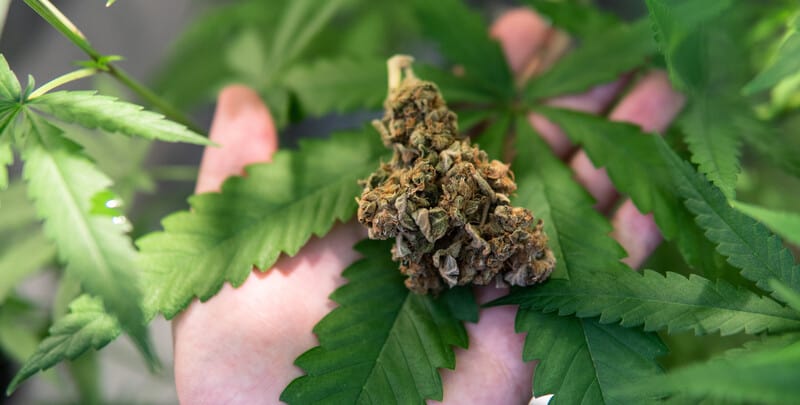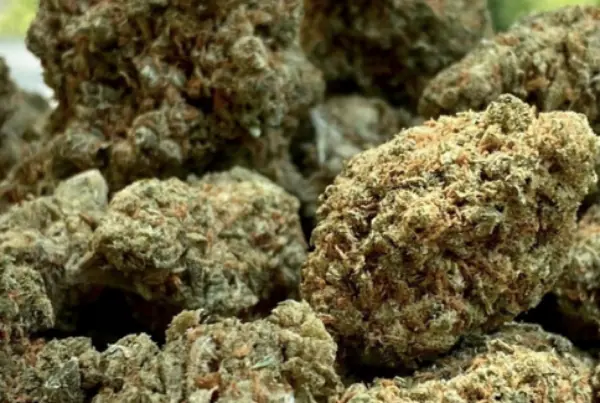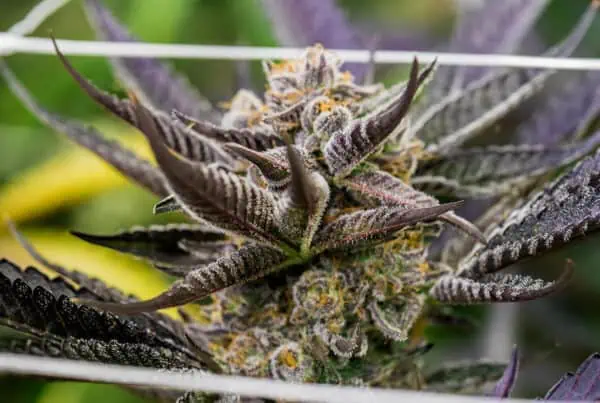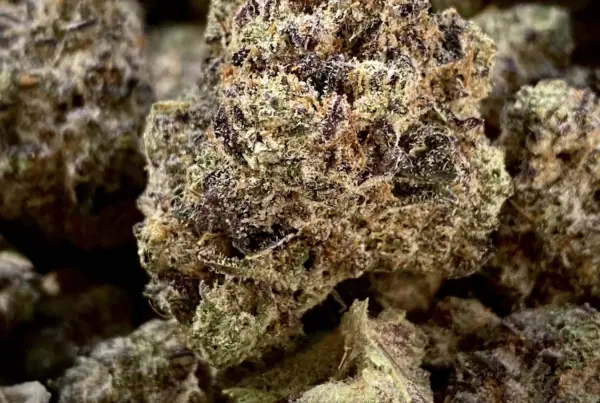TABLE OF CONTENTS
So, you like the sativa-based high that gives you the energy and motivation to make it through a tough day? You like the cerebral effects but don’t really want an overpowering physical relaxation that your friends like from their favorite indica dominant strains?
Well, we have the perfect list for you right here! Here at CTU, we know quite a few sativa fans and wanted to put together a list of the 10 best sativa dominant strains that shouldn’t be too hard to find. You’ll want to try these out!
What Is A Sativa Dominant Cannabis Strain?
Sativa dominant strains tend to grow taller than indicas. Leaves are thinner and the buds tend to be a bit smaller than those grown with indica varieties.
While many cannabis users believe there are many other differences between sativa and indica, including the difference in the high. In reality, it’s not true.

The truth is that the myth of sativas being energizing and indicas being relaxing has been passed down for so long that now the top-rated indicas in the cannabis industry are relaxing and the sativas are energizing.
So, while the genetic differences in sativas and indicas only amount to the differences in how they grow, now indicas are relaxing and sativas are energizing through selective breeding and years of feedback of what cannabis connoisseurs enjoy.
What To Expect From Sativa Weed?
The effects of sativa dominant strains are typically what you’d want from a daytime smoke session. You want some energy, motivation, focus, and creativity to boost your productivity in the day.
You really don’t want to be couch-locked or need a nap after smoking sativa. So, to make this list the marijuana strains must be energizing and motivating in some form so you sativa fans out there can blaze during the day and enjoy!
The Top 10 Sativa Dominant Strains
We made sure to only include strains that are common enough to be found in most major cannabis markets. While a certain sativa strain may be the best you’ve ever had, it doesn’t do our readers any good if it’s so rare that they can’t try it for themselves!
Lime Skunk
Lime Skunk provides consumers with a clear-headed high that delivers a good boost in energy as well. THC levels average around 19% and the abundant essence of limes makes this strain a must-try for those who appreciate designer cannabis strains and still want to have a productive day.
Lemon Meringue
Exotic Genetix crossed Lemon Skunk and Cookies and Cream to create Lemon Meringue Pie. The essence resembles a fresh slice of meringue pie with hints of citrus, diesel, and nuttiness.
This one will give you a boost of motivation and provide the stimulus to perform more physical activity with a mental euphoria.
Quantum Kush
Quantum Kush is the result of crossing Sweet Irish Kush and Timewreck. Homegrown Natural Wonders put together this wonderful cannabis strain that can produce energy and relaxation. Stress is no match for this marijuana strain that delivers around 19% THC.
The aroma is both earthy and sweet, pleasing those who enjoy the Kush heritage.
White Nightmare
If Blue Dream could be made better, what would it need? This cross of Blue Dream and White Moonshine keeps true to the Blue Dream essence with a hint of earthy hash on the tastebuds as well.
THC levels average around 23%, which can easily turn a dream into a nightmare for those who don’t have a high tolerance for THC. Otherwise, this potent cannabis strain delivers a happy euphoria filled with energy that can fight off stress and depression!
Sour Amnesia
Sour Deisel and Amnesia are both popular, so HortiLab Seeds did the right thing and bred them to create Sour Amnesia. Back in 2012, it placed 2nd in the High Times Cannabis Cup and it has been pleasing consumers since.
THC levels hover around 21% and the high is known to boost creativity. This happy daytime bud delivers a balance of tangy citrus and zesty diesel flavors that mix well.
Red Congolese
In the age of dankesteins cannabis strains that are descended from multiple generations of hybrids, landrace-based weed strains are a rarity.
Red Congolese is a blend of African sativa landrace genetics mixed in with Mexican and Afghani traits to create a cannabis strain that has risen in popularity, particularly in the California markets.
A weightless high that provides focus and clarity is commonly experienced with Red Congolese. THC levels are also known to reach 23% or higher, so beginners beware!
Tangilope
Tangie and Chocolope intertwine to create this child-strain rich in both the citrus and chocolate essences of its parents. The high can boost creativity and induce a case of the giggles. The terpene profile is strong and unique, making Tangilope a must-try.
THC levels hover around 14%, which makes it a great choice for beginners and those who want more productivity out of their day instead of an intensely psychoactive experience.
Sour Tangie
This time, Tangie is crossed with East Coast Sour Deisel. The strain has two distinct phenotypes that either lean towards the Sour Deisel or the Tangie traits, so finding the one you like may take a couple of tries.
The well-known essence of Sour Deisel seems soaked in citrus with Sour Tangie. The high is elevating and uplifting and THC levels are around 18%.
Tropicana Cookies
What is with Tangie?! Yet again, Tangie was used to create a great sativa-dominant hybrid, this time bred with the legendary GSC. The citrus and cookies aromas clash together with buds reaching THC levels around 16%.
Dirty Girl
The result of crossing Arcata Lemon Wreck, which is a hybrid of Trainwreck, and Cinderella 99. Tropical and citrus fruits align with a hint of the fresh scent of Pine-Sol for the aroma. The flavor is more like lemon candy and it is known to produce a happy and creative buzz. THC levels are typically around 19%.
What To Expect From Sativa Dominant Strains
Geographical origins and plant structure aside, there are very significant differences between the two species when it comes to how they impact the human endocannabinoid system with regard to effect. While both have important medical applications, indica imparts a more sedative and relaxing high compared to the upbeat, mentally engaging high that results from consuming sativa.
Some people react negatively to certain sativa strains because it makes them feel anxious—much like some people react negatively to the caffeine in coffee—it makes them too jittery.
To take this analogy a step further, you could say that tea drinker, who often enjoy this warm beverage in the evening for its relaxing herbal effect, are like indica smokers, while the sativa smokers are more like coffee drinkers who appreciate the wakeup and lucid qualities of the beverage they consume every morning. Without their morning coffee, the day may get off to a slow start.
When smoked, sativa is cerebral and energetic. The effect is felt mostly in the head, allowing the consumer to engage in physical activities like hiking or even housecleaning.
The high is much more motivational than that of indica, which hits the body with extreme relaxation and low energy—the “couch lock” effect cannabis users know.
After smoking indica, many people are in for the evening, content to enjoy themselves doing nothing more challenging than watching a movie.
Sativa smokers, on the other hand, may want to go out for their movie, concert, or night on the town.
More Popular Sativa Strains

When shopping for some good sativa, there are more varieties available to buyers than ever before. Although many of these sativa strains have been around for several decades, finding a number of them to choose from is a welcome and somewhat new experience.
While there are relatively few pure sativas on the market today, quite a few come close to being pure and behave like sativas with regard to their effects. Let’s take a look at 10 of the purer varieties out there that you’re likely to encounter when shopping.
Durban Poison
This is a pure landrace strain from the port city of Durban from South Africa. As a pure sativa, Durban Poison has an energetic and highly motivational effect that keeps those who consume it on their toes and active. This is a good strain for conversation and social activities. The THC levels of this strain are usually quite high in THC and low in CBD. Flavors of anise, pepper, and subtle tropical fruit make Durban Poison a tasty and powerful cannabis experience.
Haze
Haze has had such an impact on the cannabis world that a huge number of sativa-leaning strains have been created with crossing it with other varieties. Haze ranks among one of the most popular strains—and for good reason. Originally created by the Haze brothers from the Santa Cruz area of California, Haze combines Mexican, Colombian, Indian, and Thai strains to create a wonderfully flavorful and creative strain. The aroma and flavor of Haze is so distinctive that once you smell it, you will recognize it forever, as well as in strains created from it. Smooth minty and piney flavors tickle the taste buds.
Golden Goat
This strain was created in Kansas by crossing a Hawaiian strain with Island Sweet Skunk. The Hawaiian genetics result in this strain’s golden-green appearance that earns it its name. The high is upbeat and euphotic, with a slightly relaxing quality that follows the initial effect. Golden Goat is great for a sativa experience with a little balance that isn’t racey. The aroma and flavor leans to the sweeter side, with citrus notes and tropical fruit flavors. Expect a dense and sticky coating of trichomes from this strain, as well as potent THC levels and small amounts of CBD.
Kali Mist
Kali Mist is a sativa-dominant strain that remains somewhat shrouded in mystery. The genetics behind it are unknown and believed to be in a ratio of 90/10 sativa/indica, making it very close to being pure sativa. This is a great strain for morning use, because the THC content is below that of many other popular sativas, making it quite functional and clear-headed in effect. As far as flavor goes, most Kali Mist phenos have an earthy/woody/citrus combination in varying ratios. Kali Mist is a good strain for those who may not be looking for a profound cannabis experience, although its effects are quite pleasant.
Cinderella 99
This has definitely made its mark on the cannabis world, with a number of notable hybrids resulting from crosses made with it. “Cindy 99,” as it’s often referred to, was created by Brothers Grimm, an Amsterdam seed company, using genetics that include Jack Herer from Sensi Seeds. Cindy is popular with indoor growers who appreciate the plant’s short stature and quick finishing time. The THC potency is decent, with percentages often hovering in the low 20s. The strain has a sweet flavor profile, with candied citrusy notes and a distinct earthy dankness present as well.
Strawberry Cough
Strawberry Cough caused a buzz in the cannabis community when it was introduced quite a few years ago. Sativa growers love it for the same reason they appreciate Cinderella 99—short and manageable stature and quick finishing time for a strain decidedly in the sativa category. The genetics behind its creation remain unclear, but the effects mirror those of Cinderella 99, with motivational effects that aren’t immediately relaxing, mild relaxation emerges later. Strawberry Cough really delivers in the flavor department, with rich, creamy strawberry/berry flavors. The “Cough” part of the name is an exaggeration, because this strain is no more likely to make you cough than any other. The strain enjoys immense popularity and is one to seek.
Green Crack
has a name that you may not like, but it does imply an energetic effect, which this strain most definitely has. To confuse matters, there are now two versions of Green Crack, one that leans heavily to indica genetics. We’ll focus on the sativa variety here. The Green Crack experience is highly motivational and cerebral. This is a happy strain that uplifts those who use it. Knowledge about its genetics remain somewhat murky, but it’s known to contain Skunk #1. In the terpene department, Green Crack has tangy, sweet, and fruity flavors that some people compare to papaya or mango.
Jack Herer
This one is a popular award-winning strain created by Dutch seed company Sensi Seeds. Created to honor the sativa-loving marijuana activist with the same name, Jack Herer is a very popular strain for its enjoyable uplifting qualities, despite the fact that it contains a percentage of Northern Lights #5, a well known indica. The strain also contains Shiva Skunk and a Haze hybrid, resulting in a 55/45 sativa-dominant hybrid. Put any thoughts of indica aside, because Jack Herer acts like a sativa all the way. There are several phenos of Jack, with slight variation in flavor and effect. Most people favor the plants that have a slight tropical fruit flavor along with the pronounced Hazey pine that all Jack phenos seem to have. Those who cultivate cannabis, love Jack for its sativa qualities, which led to the creation of Jack Flash, a strain that finishes quicker yet maintains many of the same qualities as the pure Jack.
Bruce Banner
This is a sativa with a strong punch. Named after the Incredible Hulk character who morphs into a monster, is a powerful experience, much like the hulk character. Consisting mostly of OG Kush and Strawberry Diesel—two tasty strains in their own right—there are a few phenos, one of the most popular of which is Bruce Banner #3. From a terpene perspective, this strain usually has a candied sweetness and mildly earthy dankness, with subtle diesel notes—an interesting flavor experience for sure. Bruce Banner’s effect is mostly cerebral, a great, clear-headed strain for daytime use.
Maui Wowie,
Like Durban Poison, this is a sativa with a long history. As its name implies, Maui Wowie comes from the Hawaiian Islands. The stress-relieving, happy qualities it provides to those who partake make it perfect for conversation and gatherings with goof friends. Its moderate strength is pleasant and not overwhelming for those not used to cannabis. As a Hawaiian strain, Maui Wowie has appropriate flavors that contain tropical pineapple aromas and flavors. Take a blissful trip to the islands today by purchasing this longtime favorite.
A fine sativa strain provides an experience to remember. For people on the go, sativas add motivational qualities indicas lack—which has its own rewarding qualities and fans. The next time you shop for cannabis at your favorite dispensary, keep your eyes peeled for one or more of the strains mentioned above. They rank among some of the best and most well-known in the sativa space, and you’ll be more than happy you gave them a try!
Marijuana School
Are you interested in starting a career in the booming cannabis industry? Want to earn certifications in many areas at an online marijuana college? Sign up at the leading cannabis university today.
“
There are over 300,000 jobs in the cannabis industry. CTU trained me for one of them!

Makes $24.50 @ THC +
What Are Your Favorite Sativas?
Did your favorite sativa dominant strains make it on this top 10 list? Everybody has a difference of opinion when it comes to cannabis strains, but we are sure that’d you’d love the majority of these sativa-dominant pot strains if you tried them out for yourself!
Interesting in learning more about cannabis genetics and how to grow it yourself? Our professional cannabis growing course here at CTU is a great choice!
Sativa Strains FAQ's
What is the strongest sativa strain?
With up to 35% THC, Cafe Racer is the strongest Sativa strain. Although Jack Herer, Durban Poison, Sour Diesel, and Chocolope are known to be powerful Sativa strains, they are not quite as strong as Cafe Racer.
Is sativa an upper or downer?
Most cannabis sativa strains are uplifting and provide a “high.” The primary feature of sativa strains that elevate mood is their high limonene concentration. Certain cannabis strains, like Indica, have a sedative effect. The proportion of tetrahydrocannabinol (THC) in your system may affect the way you sleep.
Are there any 100% sativa strains?
Although they are rare, pure sativa strains do exist. It's thought that benefits from pure sativa strains could leave you feeling focused, energised, and happy. Well-known pure sativa strains include Green Crack, Maui Wowie, Sour Diesel, and Super Lemon Haze.
Can sativa strains make your eyes red?
If you consume cannabis through a vape, joint, drink, edible, or other smoking device and it contains THC (delta-9-tetrahydrocannabinol), it will cause your eyes to get red. The effect that THC exerts on your eyes causes redness. When you use cannabis, the cannabinoid THC makes you feel “high.”
Is sativa happier than indica strains?
Sativa strains are recognized for their ability to provide users a “mind high,” or an uplifting, invigorating impact that makes them feel more aware. Sativa strains frequently include larger THC and lower CBD concentrations. Indica strains have sedative qualities that can improve hunger, promote calmness, and facilitate sleep.

Gavin Kushman
Gavin is a worldly adventurer and cannabis connoisseur, embarking on journeys that take him to the far corners of the globe to explore and document the varied effects, flavors, and histories of both renowned and lesser-known strains. From the misty high-altitude farms of the Hindu Kush highlands to the vibrant cannabis cafes of Amsterdam, Gavin's quest for knowledge spans continents. A recognized authority in the cannabis industry, he frequently lends his expertise to leading publications such as Cannabis Training University, where his captivating blog articles chronicle his unique experiences with different cannabis strains.











 Jeff was involved in an accident where he endured a traumatic brain injury. He had a week-long stay in ICU where brain surgeons
Jeff was involved in an accident where he endured a traumatic brain injury. He had a week-long stay in ICU where brain surgeons  100% risk free money back guarantee within 48 hours after purchase if student has not completed any of the courses or exams.
100% risk free money back guarantee within 48 hours after purchase if student has not completed any of the courses or exams.